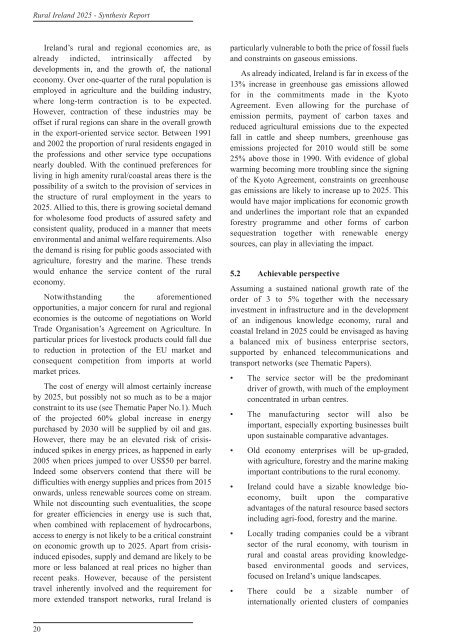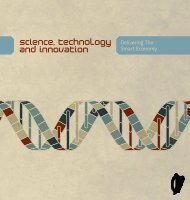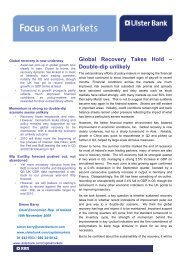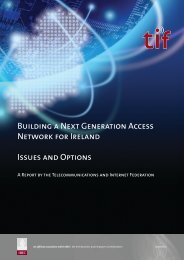RURAL IRELAND 2025 Foresight Perspectives - Coford
RURAL IRELAND 2025 Foresight Perspectives - Coford
RURAL IRELAND 2025 Foresight Perspectives - Coford
- No tags were found...
Create successful ePaper yourself
Turn your PDF publications into a flip-book with our unique Google optimized e-Paper software.
Rural Ireland <strong>2025</strong> - Synthesis ReportIreland’s rural and regional economies are, asalready indicted, intrinsically affected bydevelopments in, and the growth of, the nationaleconomy. Over one-quarter of the rural population isemployed in agriculture and the building industry,where long-term contraction is to be expected.However, contraction of these industries may beoffset if rural regions can share in the overall growthin the export-oriented service sector. Between 1991and 2002 the proportion of rural residents engaged inthe professions and other service type occupationsnearly doubled. With the continued preferences forliving in high amenity rural/coastal areas there is thepossibility of a switch to the provision of services inthe structure of rural employment in the years to<strong>2025</strong>. Allied to this, there is growing societal demandfor wholesome food products of assured safety andconsistent quality, produced in a manner that meetsenvironmental and animal welfare requirements. Alsothe demand is rising for public goods associated withagriculture, forestry and the marine. These trendswould enhance the service content of the ruraleconomy.Notwithstanding the aforementionedopportunities, a major concern for rural and regionaleconomies is the outcome of negotiations on WorldTrade Organisation’s Agreement on Agriculture. Inparticular prices for livestock products could fall dueto reduction in protection of the EU market andconsequent competition from imports at worldmarket prices.The cost of energy will almost certainly increaseby <strong>2025</strong>, but possibly not so much as to be a majorconstraint to its use (see Thematic Paper No.1). Muchof the projected 60% global increase in energypurchased by 2030 will be supplied by oil and gas.However, there may be an elevated risk of crisisinducedspikes in energy prices, as happened in early2005 when prices jumped to over US$50 per barrel.Indeed some observers contend that there will bedifficulties with energy supplies and prices from 2015onwards, unless renewable sources come on stream.While not discounting such eventualities, the scopefor greater efficiencies in energy use is such that,when combined with replacement of hydrocarbons,access to energy is not likely to be a critical constrainton economic growth up to <strong>2025</strong>. Apart from crisisinducedepisodes, supply and demand are likely to bemore or less balanced at real prices no higher thanrecent peaks. However, because of the persistenttravel inherently involved and the requirement formore extended transport networks, rural Ireland isparticularly vulnerable to both the price of fossil fuelsand constraints on gaseous emissions.As already indicated, Ireland is far in excess of the13% increase in greenhouse gas emissions allowedfor in the commitments made in the KyotoAgreement. Even allowing for the purchase ofemission permits, payment of carbon taxes andreduced agricultural emissions due to the expectedfall in cattle and sheep numbers, greenhouse gasemissions projected for 2010 would still be some25% above those in 1990. With evidence of globalwarming becoming more troubling since the signingof the Kyoto Agreement, constraints on greenhousegas emissions are likely to increase up to <strong>2025</strong>. Thiswould have major implications for economic growthand underlines the important role that an expandedforestry programme and other forms of carbonsequestration together with renewable energysources, can play in alleviating the impact.5.2 Achievable perspectiveAssuming a sustained national growth rate of theorder of 3 to 5% together with the necessaryinvestment in infrastructure and in the developmentof an indigenous knowledge economy, rural andcoastal Ireland in <strong>2025</strong> could be envisaged as havinga balanced mix of business enterprise sectors,supported by enhanced telecommunications andtransport networks (see Thematic Papers).• The service sector will be the predominantdriver of growth, with much of the employmentconcentrated in urban centres.• The manufacturing sector will also beimportant, especially exporting businesses builtupon sustainable comparative advantages.• Old economy enterprises will be up-graded,with agriculture, forestry and the marine makingimportant contributions to the rural economy.• Ireland could have a sizable knowledge bioeconomy,built upon the comparativeadvantages of the natural resource based sectorsincluding agri-food, forestry and the marine.• Locally trading companies could be a vibrantsector of the rural economy, with tourism inrural and coastal areas providing knowledgebasedenvironmental goods and services,focused on Ireland’s unique landscapes.• There could be a sizable number ofinternationally oriented clusters of companies20








